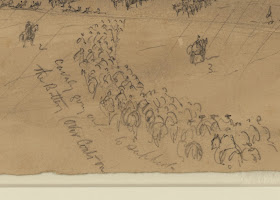 |
Waud, "Battle of Darby Town Rd. Gen'l Butler & his staff," Library of Congress |
Here's a look at an eyewitness sketch of the fighting outside Richmond on October 27, 1864.
On that day, Grant launched his sixth offensive of the Richmond-Petersburg Campaign. During this operation, General Benjamin Butler's Army of the James tested Richmond's defenses east of the city, while George Meade's Army of the Potomac attacked the Confederate lines at Petersburg in an effort to seize the vital South Side Railroad.
Early in the morning on the 27th, Butler and his staff rode west along the Darbytown Road and set up headquarters at Dr. Johnson's house, which stood on what is now Dorey Park. Just to the north and west of the house, Alfred Terry's Tenth Corps troops, more specifically the men of Adelbert Ames's division, deployed to push against Richmond's defenders to the west.
Looking north from Dr. Johnson's house, English-born artist William Waud captured the scene:
Waud, along with other artists during the war, created hundreds of sketches, which, in the absence of combat photography, provided first-hand impressions of the battlefield. William's older brother, Alfred, also created many well-known drawings during the conflict. In 1864, both brothers worked for Harper's Weekly, published in New York. In fact, the Library of Congress catalog identifies Alfred, incorrectly in my opinion, as the artist of the piece displayed here. In my view, William is likely the artist because: 1) he prepared other sketches outside Richmond and Petersburg that day, including one at Dr. Johnson's house; 2) his brother Alfred had been in Washington, D.C. as recently as October 23rd after several weeks in the Shenandoah Valley; and 3) Alfred frequently wrote his initials on the bottom right hand corner of his work - initials missing from this drawing.
 |
| Left (West) Half of Sketch |
 |
| Right (East) Half of Sketch |
Waud appears to have prepared his sketch from the second floor window of Dr. Johnson's house, looking north toward the Darbytown Road, which runs through the middle of the drawing immediately in front of the stand of trees on the right.
 |
| LC Civil War Maps (2nd ed.), 632.7 |
This particular drawing reveals a trove of information about the October 1864 battles in this area. It displays the location of the Union skirmish line on the 27th, supporting artillery that morning, key landmarks north of Darbytown Road (most notably the "Gerhardt" house), and the landscape surrounding Dr. Johnson's Farm (or "Plainfield"). The sketch not only uncovers valuable details about the October 27, 1864 operation, but also shows the ground over which other battles occurred earlier that month. In an October 7 engagement at the Darbytown Road, Robert E. Lee's infantry swept over August Kautz's cavalry division, pushing the Union troopers toward the viewer in Waud's sketch and south to the safety of the Union lines on the New Market Road. In addition, on October 13, the Union Tenth Corps conducted a costly reconnaissance advancing right to left across this scene in an effort to locate new Confederate trenches to the east.
Is this sketch entirely accurate? Probably not. It was not uncommon for the battlefield artists to take liberties with the scenes they rendered due perhaps to time constraints or the desire to create drawings that their editors would want to print. In fact, the scene here probably depicts a composite of events that occurred over the course of the morning. For example, it is unlikely that Butler, not one to rush forward, rode out with this staff so near the heat of the skirmish line, as suggested in the sketch (see #1 below). Any excursion conducted by Butler probably occurred later in the day, after the Union troops had pushed further west (i.e., to the left of the sketch).
Waud often scribbled copious notes on his drawings to help the engravers and editors back north. Here are four of the more notable messages from the sketch:
 |
#1 "Butler's Staff & Body Guard"
#2 "1st Connecticut Battery - Capt. Clinton"
#3 "Our skirmish firing at the rebels in the woods; the Gerhardt-House"
#4 "Cavalry going out to support the Battery (over coats - on)"
A correspondent from the New York Times also witnessed the day's events from Dr. Johnson's house and provided the following description, which augments Waud's sketch:
"From the upper windows of Dr. Johnson’s house, a very fair view of the skirmish line could be had. Our pickets were lying behind a small breastwork, about one hundred yards from the edge of trees, and all day long a desultory firing was kept up. There was nothing very exciting in all this. One becomes even tired of watching the little puffs of blue smoke that invariably follows the sudden rising of one of the crouching black specks whom we know to be men lying down along the distant parapet, as well as of noting the little clouds of gray dust that are thrown up by the rebel bullets which strike the ground in front of our boys, who are snug under shelter of the ridge of earth." - New York Times, October 31, 1864.



